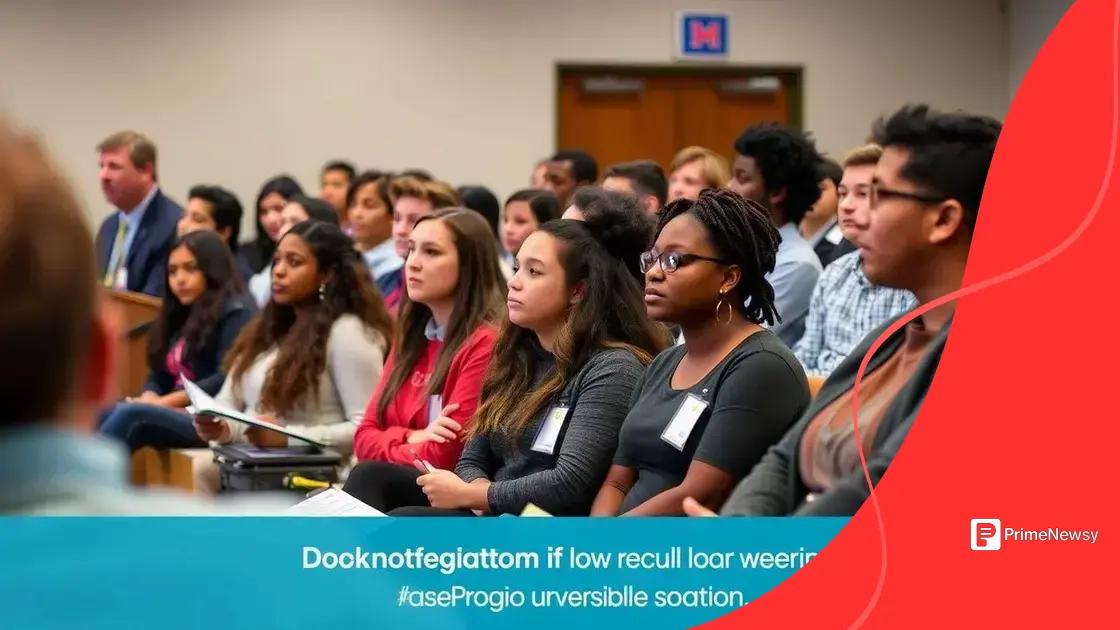Student debt crisis solutions: practical approaches

Anúncios
Student debt crisis solutions include exploring alternative funding options, understanding government policies, and adopting effective loan management strategies to alleviate financial burdens on students.
Student debt crisis solutions are crucial for many individuals navigating the complex world of higher education financing. Have you ever felt overwhelmed by the thought of student loans? You’re not alone, and there are paths to finding relief.
Anúncios
Understanding the student debt crisis
Understanding the student debt crisis is essential for anyone navigating higher education today. The rising costs of tuition and living expenses have led to a staggering amount of debt for millions of students. This issue not only affects individuals but also has broader implications on the economy.
What Contributes to the Student Debt Crisis?
Several factors play a role in escalating student debt:
- Increasing tuition costs at colleges and universities.
- Limited availability of scholarships and grants.
- High living expenses, particularly in urban areas.
- Rising interest rates on student loans.
Furthermore, many students do not fully understand the financial commitments they are making when they take out loans. This lack of financial literacy can lead to poor decision-making and increased debt burdens.
Anúncios
The Impact of Student Debt
The ramifications of the student debt crisis extend beyond individual borrowers. Many graduates find themselves unable to purchase homes or start businesses due to their loan obligations. This situation can create a ripple effect throughout the economy.
Consider these impacts:
- Delayed entry into the housing market.
- Lower rates of entrepreneurship among graduates.
- Reduced consumer spending in other areas due to debt payments.
It’s clear that tackling the student debt crisis requires a multi-faceted approach that includes improving financial literacy and ensuring that students have access to affordable education.
Financial literacy for students
Financial literacy for students is essential for ensuring financial stability after graduation. Understanding how to manage money effectively can help students navigate the challenges of student debt and future expenses.
Many students do not receive adequate education on personal finance during their schooling. With the rising costs of education, having a strong grasp on financial management is more crucial than ever. It empowers students to make informed decisions about loans, budgeting, and savings.
Key Components of Financial Literacy
To build a solid foundation of financial literacy, students should focus on several key areas:
- Understanding different types of loans and interest rates.
- Creating and sticking to a budget.
- Knowing how to manage credit and debt.
- Investing for the future and understanding savings accounts.
Equipping students with this knowledge will not only help them manage their current financial situations but also prepare them for financial independence in the future. Resources such as workshops, online courses, and financial apps can facilitate this learning process.
Practical Tips for Students
Students can practice financial literacy in everyday life. For instance, they can track their expenses using apps or spreadsheets, which allows them to see where their money goes. Setting financial goals is also an important step toward becoming financially savvy.
Moreover, students should seek out mentorship. Speaking with individuals who have successfully managed their finances can provide valuable insights. Peer discussions and group studies can reinforce learning and foster accountability.
Government policies addressing student loans

Government policies addressing student loans play a vital role in shaping the financial landscape for students. As the burden of student debt continues to grow, various policies aim to alleviate this crisis and make education more accessible.
Many initiatives focus on reducing interest rates or offering loan forgiveness options for specific groups, like teachers or public service workers. Additionally, some programs emphasize income-driven repayment plans, which adjust monthly payments based on a borrower’s income.
Key Government Policies
Several significant policies help manage student loan debt:
- The Public Service Loan Forgiveness Program, which forgives loans after 120 qualifying payments.
- Income-Driven Repayment Plans, where payments are capped based on income.
- Temporary relief measures introduced during economic crises, such as the pause on federal student loan payments due to the COVID-19 pandemic.
Understanding these policies can empower students to make informed choices about their education financing. For example, knowing about loan forgiveness can motivate students to pursue careers in public service.
Challenges and Changes
Despite these efforts, challenges remain. Not all borrowers qualify for forgiveness, and some policies can be complicated to navigate. Students may need support and guidance to understand their options fully. Initiatives to improve transparency in loan terms and student resources are essential in ensuring that students are well-informed.
Furthermore, as the landscape shifts, government policies must adapt to meet the evolving needs of students. Advocating for reform and better solutions will be crucial for addressing the student debt crisis effectively.
Alternative funding options for education
Alternative funding options for education offer students different paths to finance their studies without relying solely on traditional student loans. Exploring these options can provide relief from the heavy burden of debt.
Many students are unaware of the variety of funding sources available to them. Scholarships and grants can significantly reduce the cost of education and are often based on merit or need. They do not have to be repaid, making them an ideal solution for many.
Types of Alternative Funding
Consider these common types of alternative funding options:
- Scholarships – Offered by schools, private organizations, or businesses. These are awarded based on various criteria, such as academic achievement or community service.
- Grants – Typically need-based funds provided by the government or institutions, which do not require repayment.
- Crowdfunding – Some students turn to platforms like GoFundMe to raise money for their education directly from family, friends, and social networks.
- Work-study programs – These allow students to work part-time while studying, earning money that can be applied towards tuition and living expenses.
By taking advantage of these options, students can minimize their reliance on loans. Each funding option has unique benefits, and students should consider which best fits their situation and goals.
Effective Strategies for Securing Funding
To enhance their chances of receiving financial support, students should begin their search early. Applying for multiple scholarships and grants increases opportunities. Additionally, tailoring applications to specific requirements can lead to better results.
Networking with alumni and attending college fairs can also uncover lesser-known funding resources. Engaging with community organizations may open doors for local scholarships as well.
Strategies for managing and repaying loans
Strategies for managing and repaying loans can greatly ease the financial burden many students face after graduation. Understanding these strategies is crucial for navigating the complexities of student debt.
One effective method includes creating a detailed budget. By tracking income and expenses, students can identify areas to save money, which can then be redirected towards loan payments. This approach not only helps in managing existing debt but also promotes healthy financial habits.
Loan Repayment Plans
Students should explore various loan repayment plans available to them:
- Standard Repayment Plan – Fixed monthly payments over ten years.
- Income-Driven Repayment Plans – Monthly payments based on income and family size.
- Graduated Repayment Plan – Lower initial payments that gradually increase every two years.
- Extended Repayment Plan – Payments spread over a longer term, which can lower monthly obligations but may increase total interest paid.
Choosing the right plan depends on individual financial circumstances. It’s important to assess which option aligns best with personal goals and situations. Checking eligibility for forgiveness programs can also significantly affect repayment strategy.
Additional Tips for Loan Management
Students should also consider making extra payments whenever possible. This can reduce the overall interest accrued on loans. Setting up automatic payments can ensure bills are paid on time, leading to potential interest rate reductions offered by some lenders.
Furthermore, maintaining communication with loan servicers is essential. They can provide support in understanding loan terms and options for deferment or forbearance if financial challenges arise. Building a good relationship with servicers can also aid in resolving any issues that may occur.
FAQ – Frequently Asked Questions about Student Debt Solutions
What strategies can help manage student loans effectively?
Creating a budget, choosing the right repayment plan, and making extra payments can significantly help manage student loans.
Are there any alternatives to traditional student loans?
Yes, students can explore scholarships, grants, work-study programs, and crowdfunding options to finance their education.
How can government policies affect student loan repayment?
Government policies offer various repayment plans, forgiveness options, and relief measures that can ease the burden of student loans.
What should I do if I have difficulty managing my student debt?
Stay in communication with your loan servicer, seek financial advice, and explore deferment or forbearance options if necessary.